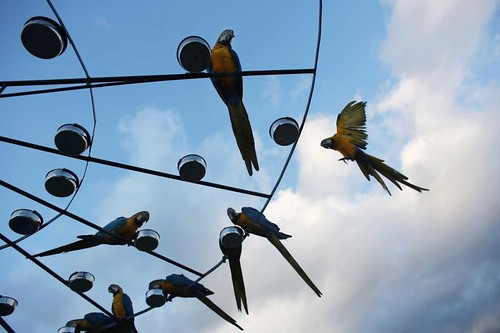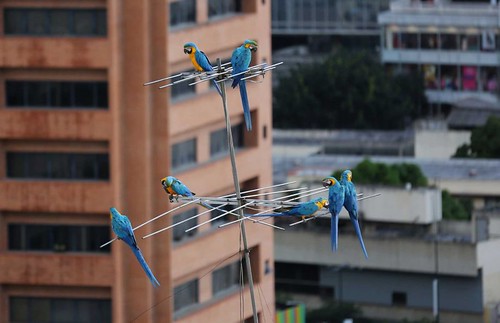 In this Nov. 19, 2014 photo, macaws perch on an antenna in Caracas, Venezuela. The city of around 6 million people does not seem welcoming for exotic birds. But the macaws supplement the food they forage with snacks the birders leave for them. They are a common site sitting on the ledges of high-rise buildings or perched on antennas. While solid figures don’t exist, the population of macaws in Caracas is estimated to be several hundred. CARACAS, Venezuela (AP) — In one of the world's most hostile urban jungles, the spectacle of rainbow-colored tropical birds streaking across the late-afternoon sky has become a natural respite from rampant crime and choking pollution.
In this Nov. 19, 2014 photo, macaws perch on an antenna in Caracas, Venezuela. The city of around 6 million people does not seem welcoming for exotic birds. But the macaws supplement the food they forage with snacks the birders leave for them. They are a common site sitting on the ledges of high-rise buildings or perched on antennas. While solid figures don’t exist, the population of macaws in Caracas is estimated to be several hundred. CARACAS, Venezuela (AP) — In one of the world's most hostile urban jungles, the spectacle of rainbow-colored tropical birds streaking across the late-afternoon sky has become a natural respite from rampant crime and choking pollution.
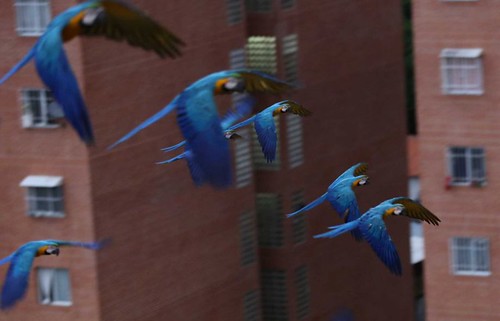 Macaws fly over the city in Caracas, Venezuela. Macaws are thriving amid the high-rises and traffic of Caracas thanks to a group of amateur birders who feed them and watch out for their nests. Visitors to Venezuela’s capital soon grow accustomed to lifting their heads at dusk and dawn to see the stately birds glide by, usually in a pair. Macaws are thriving amid the high-rises and traffic of Caracas thanks to a group of amateur birders who feed them and watch out for their nests. Visitors to Venezuela's capital soon grow accustomed to lifting their heads at dusk and dawn to see the stately birds glide by, usually in a pair.
Macaws fly over the city in Caracas, Venezuela. Macaws are thriving amid the high-rises and traffic of Caracas thanks to a group of amateur birders who feed them and watch out for their nests. Visitors to Venezuela’s capital soon grow accustomed to lifting their heads at dusk and dawn to see the stately birds glide by, usually in a pair. Macaws are thriving amid the high-rises and traffic of Caracas thanks to a group of amateur birders who feed them and watch out for their nests. Visitors to Venezuela's capital soon grow accustomed to lifting their heads at dusk and dawn to see the stately birds glide by, usually in a pair.
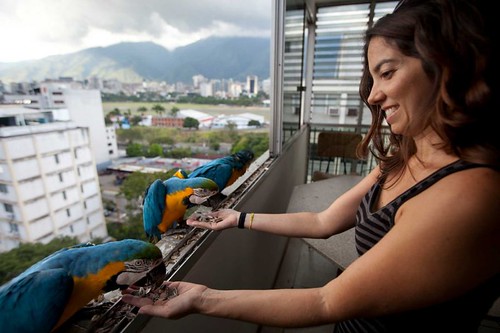 Vanessa Silva, 38, feeds macaws that fly to her apartment window every day looking for food, in Caracas, Venezuela. A group of gold-and-royal blue birds poked their heads through Silva’s window, as if saying “I’m here, is anyone home?” “I’d seen them flying when I was down on the street, and I thought ‘Oh how pretty,’” the 38-year-old said, a macaw eating out of her hand. Some, like Ivo Contreras, even invite the parrots to stop by. He has built a circular platform with 58 feeder bowls on the roof of his apartment to attract macaws.
Vanessa Silva, 38, feeds macaws that fly to her apartment window every day looking for food, in Caracas, Venezuela. A group of gold-and-royal blue birds poked their heads through Silva’s window, as if saying “I’m here, is anyone home?” “I’d seen them flying when I was down on the street, and I thought ‘Oh how pretty,’” the 38-year-old said, a macaw eating out of her hand. Some, like Ivo Contreras, even invite the parrots to stop by. He has built a circular platform with 58 feeder bowls on the roof of his apartment to attract macaws.
"For me, it's a pleasure to see them come every day ... to share a space with them where you can recharge and find harmony," said Contreras, who is a stylist for the Miss Venezuela beauty contest.
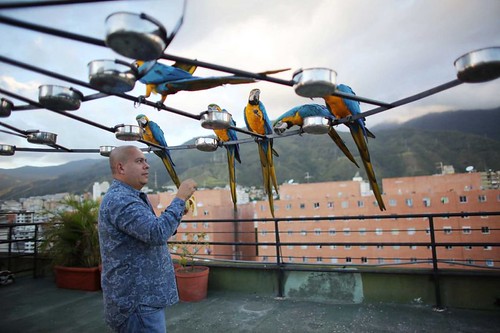 macaws feed perched on a circular platform with 58 feeder bowls on the roof of apartment in Caracas, Venezuela. City resident and bird lover, Ivo Contreras built the circular platform to attract the macaws. "For me, it’s a pleasure to see them come every day ... to share a space with them where you can recharge and find harmony," said Contreras, 44, who is a stylist for the Miss Venezuela beauty contest.Wild parrots that escaped or were released are an increasingly common sight in metropolises around the world, from the cherry-headed conures of San Francisco's Telegraph Hill to the thousands of parakeets that have taken residence in London.
macaws feed perched on a circular platform with 58 feeder bowls on the roof of apartment in Caracas, Venezuela. City resident and bird lover, Ivo Contreras built the circular platform to attract the macaws. "For me, it’s a pleasure to see them come every day ... to share a space with them where you can recharge and find harmony," said Contreras, 44, who is a stylist for the Miss Venezuela beauty contest.Wild parrots that escaped or were released are an increasingly common sight in metropolises around the world, from the cherry-headed conures of San Francisco's Telegraph Hill to the thousands of parakeets that have taken residence in London.
Caracas' signature bird is the blue-and-yellow macaw, a bird native to much of South America, though not to the valley that holds Venezuela's capital. Legend has it that it was introduced in the 1970s by Italian immigrant Vittorio Poggi, who says he nurtured a lost macaw and trained it to fly with his motorcycle as he cruised around his neighborhood.
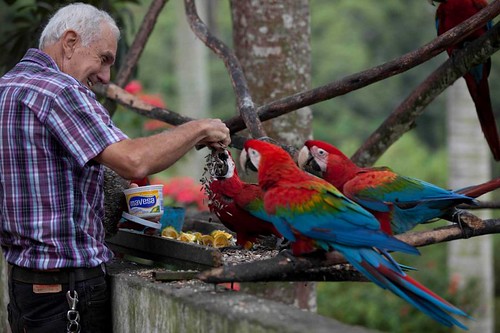 Vittorio Poggi, 70, an Italian immigrant feeds sunflower seeds to red macaws at his house in San Antonio De Los Altos at the outskirts of Caracas, Venezuela. Poggi is credited with the introducing the macaws to the valley where Caracas is situated in the 1970's, who says he found and nurtured a lost macaw, and trained it to fly next to his motorcycle as he cruised around his neighborhood.He went on to release more than 100 of the birds, some of which he bought or bred and some of which were pets given to him.
Vittorio Poggi, 70, an Italian immigrant feeds sunflower seeds to red macaws at his house in San Antonio De Los Altos at the outskirts of Caracas, Venezuela. Poggi is credited with the introducing the macaws to the valley where Caracas is situated in the 1970's, who says he found and nurtured a lost macaw, and trained it to fly next to his motorcycle as he cruised around his neighborhood.He went on to release more than 100 of the birds, some of which he bought or bred and some of which were pets given to him.
The macaws are now a common sight on the ledges of high-rise buildings or perched on antennas. While solid figures don't exist, the population of macaws in Caracas is estimated to be several hundred.
 Macaws perch on a structure atop a building in Caracas, Venezuela. Macaws are thriving amid the high-rises and traffic of Caracas thanks to a group of amateur birders who feed them and watch out for their nests. Caracas residents are trying to preserve the birds' breeding places, said Miguel Lentino, scientific director of the Caracas-based Phelps Ornithological Collection.
Macaws perch on a structure atop a building in Caracas, Venezuela. Macaws are thriving amid the high-rises and traffic of Caracas thanks to a group of amateur birders who feed them and watch out for their nests. Caracas residents are trying to preserve the birds' breeding places, said Miguel Lentino, scientific director of the Caracas-based Phelps Ornithological Collection.
"There is an attitude of defense and protection because everyone likes to see macaws near their homes, not in a cage," Lentino said.
 Residents look at pictures of macaws as they gather at a park, as part of a group called "Macaws in Caracas, " in Caracas, Venezuela. The informal group that has more than 2,000 members, shares stories about their encounters with the birds_ the fright they felt the first time they saw one at their window, the way they learned to identify repeat visitors, and how some macaws seem to learn to recognize a call to come in and eat.Bird-lovers swap experiences and advice at meet-ups organized by "Macaws in Caracas," an informal group that has more than 2,000 members.
Residents look at pictures of macaws as they gather at a park, as part of a group called "Macaws in Caracas, " in Caracas, Venezuela. The informal group that has more than 2,000 members, shares stories about their encounters with the birds_ the fright they felt the first time they saw one at their window, the way they learned to identify repeat visitors, and how some macaws seem to learn to recognize a call to come in and eat.Bird-lovers swap experiences and advice at meet-ups organized by "Macaws in Caracas," an informal group that has more than 2,000 members.
A group of gold-and-royal blue birds poked their heads through Vanessa Silva's window on a recent afternoon, as if saying, "I'm here, is anyone home?"
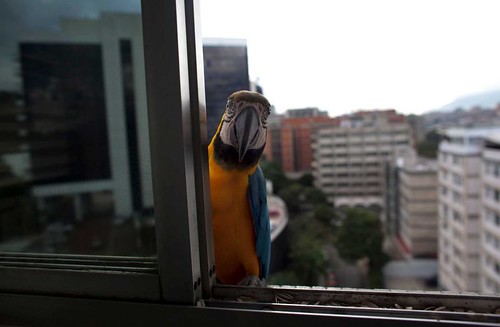 Blue & Gold macaw peers through a window of an apartment waiting to be fed, in Caracas, Venezuela. "I'd seen them flying when I was down on the street, and I thought, 'Oh how pretty,'" she said while a macaw ate out of her hand.
Blue & Gold macaw peers through a window of an apartment waiting to be fed, in Caracas, Venezuela. "I'd seen them flying when I was down on the street, and I thought, 'Oh how pretty,'" she said while a macaw ate out of her hand.
After they'd had their fill, the birds flew off against the setting sun. Macaws feed on bananas left for them while they stand on the window ledge of an apartment in Caracas, Venezuela. The city of around 6 million people does not seem welcoming for exotic birds. But the macaws supplement the food they forage with snacks birders leave for them.
Macaws feed on bananas left for them while they stand on the window ledge of an apartment in Caracas, Venezuela. The city of around 6 million people does not seem welcoming for exotic birds. But the macaws supplement the food they forage with snacks birders leave for them.  Macaws eat perched on a circular platform with 58 feeder bowls on the roof of an apartment building in Caracas, Venezuela.
Macaws eat perched on a circular platform with 58 feeder bowls on the roof of an apartment building in Caracas, Venezuela.